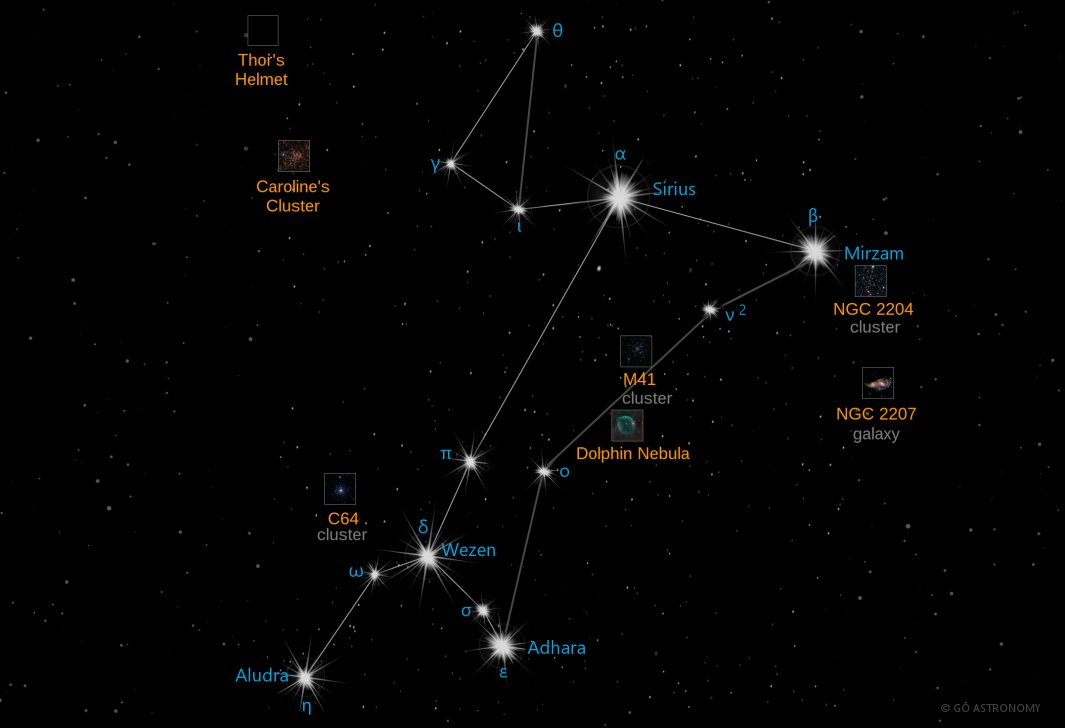Canis Major, the Greater Dog (CMa)
(CAN-iss MAY-jer)
The Southern constellation of Canis Major, the Greater Dog, is best viewed in Winter during the month of February.
Canis Major is the 43rd largest constellation. It's brightest star is Sirius at magnitude -1.46. The boundary of the Canis Major constellation contains 9 stars that host known exoplanets.
Sirius is the 7th closest star to Earth at 8.66 light years. Red hypergiant VY Canis Majoris is the 7th largest known star in the universe at 1,400 times the size of the Sun.
- Pronunciation:
- CAN-iss MAY-jer
- Meaning:
- Greater Dog
- Genitive:
- Canis Majoris
- Abbreviation:
- CMa
- Constellation Family:
- Orion
- Hemisphere:
- Southern
- Quadrant:
- SQ2
- Visibility:
- 60° N - 90° S
- Best viewing month*:
- February
- Area:
- 380 sq. degrees
- Size:
- 43rd largest
- Right Ascension (avg):
- 6h 50m
- Declination (avg):
- -23°
- Brightest star:
- Sirius (-1.46)
- Stars with planets:
- 9
Brightest Stars in Canis Major
The 10 brightest stars in the constellation Canis Major by magnitude.
- Star
- Magnitude
- Spectral class
- Alpha Canis Majoris (α Cma)
- -1.46
- A0m
- Epsilon Canis Majoris (ε Cma)
- 1.5
- B2II
- Delta Canis Majoris (δ Cma)
- 1.83
- F8Ia
- Beta Canis Majoris (β Cma)
- 1.98
- B1II/III
- Eta Canis Majoris (η Cma)
- 2.45
- B5Ia
- Zeta Canis Majoris (ζ Cma)
- 3.02
- B2.5V
- Omicron2 Canis Majoris (ο2 Cma)
- 3.02
- B3Ia
- Sigma Canis Majoris (σ Cma)
- 3.49
- K4III
- Kappa Canis Majoris (κ Cma)
- 3.5
- B1.5IVne
- Omicron Canis Majoris (ο1 Cma)
- 3.89
- K3Iab
Star Clusters in Canis Major
The most notable and easy-to-find star clusters in the constellation Canis Major . Also see all star clusters.
- Star cluster
- Catalog #
- Cluster type
- Collinder 140
- open
- Messier 41
- M41
- open
- Mexican Jumping Star
- C64
- open
- NGC 2204
- open
- NGC 2360
- open
Nebulae in Canis Major
Notable and easy-to-find nebulae in the constellation Canis Major. Also see all nebulae.
Galaxies in Canis Major
The most notable galaxies in the constellation Canis Major. Also see all galaxies.
Milky Way Satellites in Canis Major
Dwarf satellite galaxies that orbit the Milky Way Galaxy located in the constellation Canis Major. Also see all Milky Way satellite galaxies.
- Galaxy name
- Alt name
- Magnitude
- Canis Major Dwarf
The Greater Dog to the Stars
Canis Major is a constellation in the southern celestial hemisphere. It represents the 'Greater Dog' in Latin and is famed for being the home of Sirius, the brightest star in the night sky. Canis Major, with its array of intriguing deep-sky objects and its historical significance, offers a wealth of exploration for both professional astronomers and stargazing enthusiasts alike.
Historical Overview
Canis Major is one of the 48 constellations listed by the 2nd-century Greek astronomer Ptolemy, and it remains one of the 88 modern constellations defined by the International Astronomical Union. In ancient times, Canis Major was depicted as one of the dogs following Orion, the hunter in Greek mythology.
Location and Notable Features
Canis Major is located in the second quadrant of the southern hemisphere (SQ2) and can be seen at latitudes between +60? and -90?. It is bordered by Monoceros to the north, Lepus to the west, Puppis to the south, and Columba and Pictor to the east.
The constellation is most notable for Sirius, also known as the Dog Star. Sirius is the brightest star in the night sky, with a magnitude of -1.46, which is nearly twice as bright as Canopus, the second brightest star. Located a mere 8.6 light-years away from Earth, Sirius is also one of our closest stellar neighbours.
Deep Sky Objects
While Canis Major is best known for its bright star Sirius, it also hosts several deep-sky objects. These include open star clusters and some fainter galaxies.
Messier 41 (M41), an open star cluster located about 4 degrees south of Sirius, is a notable object. It is a relatively bright cluster that can be seen with the naked eye under ideal conditions and contains about 100 stars, the brightest of which is a red giant.
Additionally, several galaxies like NGC 2207 and IC 2163, which are in the process of colliding, reside within the boundaries of Canis Major, although these objects require a telescope to be seen.
Observing Canis Major
For observers in the Northern Hemisphere, Canis Major is a winter constellation. It is visible in the southern sky during evenings from December through March. Observers in the Southern Hemisphere have an advantage as the constellation passes directly overhead in the summer.
Locating Canis Major is quite straightforward due to the prominence of Sirius. Once Sirius is found, the rest of the constellation's primary stars, which form a simple, stick-figure pattern, can be identified with relative ease.
For those interested in viewing the deep-sky objects within Canis Major, such as M41, a modest telescope or good pair of binoculars will be required. Dark skies, away from city lights, will provide the best viewing conditions.
* Constellation shown for northen hemisphere skies. For the southern hemisphere, constellations appear rotated 180 degrees (upside-down and left-right reversed) from what is shown. Remember that seasons are reversed too - summer in northern latitudes is winter in southern latitudes.
** Circumpolar constellations are visible year-round in the hemisphere listed (and not at all in the opposite hemisphere).





